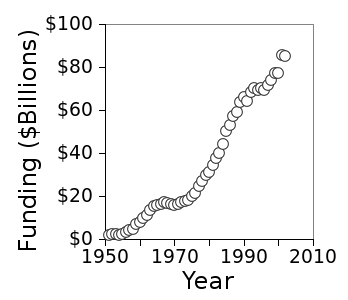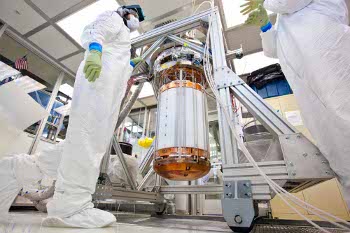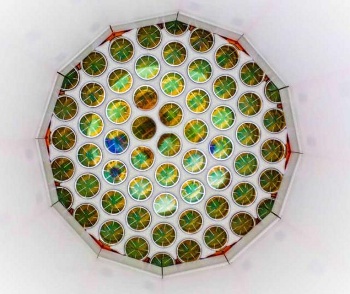LUX Dark Matter Search
November 20, 2013
I received my
undergraduate physics degree during the dark days of physics funding at the start of the
1970s. At that time,
US government funding of science had been stagnant for many years, and it would continue to be stagnant for years to come (see figure).[1] This was a consequence of the
Vietnam War, which drained both the country's wallet, and its spirit.

The end of the 1960s, and the start of the 1970s, was a bad time for science in the United States.
(National Science Foundation data from ref. 1, graphed using Gnumeric.[1]
Although I was a
physicist, I had always enjoyed
engineering research, and I tried finding a suitable job in that area after graduation. Alas, none could be found, so I did what many unemployed graduates do today, I went to
graduate school. I had read in articles in
economics journals that the real purpose of
college was not to
educate, but to keep people out of the job market for four years. Suddenly, the purpose of graduate school was to keep educated people out of the job market for a few additional years.
Graduate school was different, too. I could get a
research assistantship in
materials science, but not in physics, so that's how I became a
materials scientist.
Shakespeare's phrase, "
A rose by any other name...," is actually true. In the end, my
solid state physics colleagues and I had taken equivalent courses, sometimes siting in the same
classrooms; and, we were doing similar
experiments, and
graduated to compete for the same jobs.
Those dark days of physics are long past, and now there's the brighter darkness of well funded experiments for elucidating dark
dark matter. As I wrote in a
previous article (Whither WIMPs, November 22, 2010), about 80% of the mass of the universe is supposed to consist of
weakly interacting massive particles (WIMPs). These particles, invisible because they do not interact
electromagnetically, only
gravitationally, are the supposed components of dark matter.
One way to detect this sort of
particle is to monitor a huge quantity of an indicator material of large
nuclei and hope for an interaction. This approach has been ongoing in the
XENON Dark Matter Search Experiment, which uses a vat of liquid
xenon as the detector. Interaction between a WIMP and xenon will produce both a
scintillation and an
ionization, so a WIMP interaction will have a particular interaction "signature."
Xenon (
atomic number 54) has many stable
isotopes with nuclei that contain 70 or more
neutrons, so there's hope for some interaction. One problem is distinguishing a dark matter interaction from others caused by
background sources, such as
cosmic rays and local
radioactive sources. WIMP interaction with normal matter has been estimated to be anywhere from a single event per
kilogram per year to a single event per
ton per year.[2]
The XENON Dark Matter Search Experiment operates at the
Gran Sasso Underground Laboratory (Laboratori Nazionali del Gran Sasso) in
Italy, where it's protected from most cosmic radiation. This experiment has not detected any WIMPs over several years of operation. However, no result is still a result in that it places a limit on what a WIMP might be. At this point, The cross-section of the WIMP-nucleon interaction is about 10
-45 cm
2.
The XENON Dark Matter Search Experiment isn't the only xenon-based experiment in search of WIMPs. There's also the
Large Underground Xenon Detector (LUX).[3-13] Like the XENON Dark Matter Search Experiment, LUX is located in an underground laboratory, the
Sanford Underground Laboratory, built into an abandoned
mile-deep gold mine in
Lead, South Dakota. LUX has several times more liquid xenon than the XENON Dark Matter Search Experiment.

The LUX detector, a six-foot-tall titanium tank filled with about 600 pounds of liquid xenon.
(Photo by Matt Kapust/Sanford Underground Research Facility, via Brown University.)
The key to such an experiment is reduction in background signals. Aside from it's being located in a
cavern 4,850 feet underground, the detector is surrounded by 70,000
gallons of
water, and it's made from
titanium and
Teflon, which have no natural radioactivity.[4,10] The cavern is the same place where
Raymond Davis, Jr., winner of the 2002
Nobel Prize in Physics, detected
solar neutrinos using a container filled with 100,000 gallons of the common
dry-cleaning chemical,
tetrachloroethylene as a detector.[5,10,12] I wrote about the Davis experiment in a
previous article (Bacterial Iron Isotopes, July 22, 2013).
LUX is funded by the US
National Science Foundation and the
United States Department of Energy.[9] The Sanford Lab is owned by
South Dakota, which is one way to
stimulate the local economy, and it was made possible through a a $70 million donation by
philanthropist T. Denny Sanford.[5] Lux is a huge scientific collaboration involving seventeen
research universities and national
laboratories in the United States, the
United Kingdom,
Portugal, and
Russia; so the result of its first, 85-day
experiment, has gotten a lot of press coverage.[4-13] This is all the more interesting, since what was reported at an October 30, 2013, webcast was a
null result.
Yale University physicist,
Daniel McKinsey, who is on the LUX team, is quoted in
Wired as saying, "Basically, we saw nothing. But we saw nothing better than anyone else so far."[10]

Photomultiplier arrays are placed at the top and bottom of the LUX liquid xenon container to record scintillations.
(Photo by Matt Kapust/Sanford Underground Research Facility, via Brown University.)
The LUX detector was filled with liquid xenon in February of this year, and it completed a baseline run of 85 days during the summer, followed by
data analysis. There were 160 detected events, and all of these were determined to have been produced by background radiation, and not by WIMPs.[4-5,7,13] This result rules out some supposed positive events seen at other experiments.
LUX is twice as sensitive to heavy WIMPs than XENON, but it's nearly twenty times more sensitive to WIMPs of low mass.[10] For this reason, these data seem to rule-out models for WIMPs in the 33 GeV mass range.[13] Specifically rejected are early claims of WIMP detection by three other experiments,
DAMA (DArk MAtter), the
Cryogenic Dark Matter Search (CDMS), and the
Coherent Germanium Neutrino Technology (CoGeNT).[8] CoGeNT had reported a WIMP in the 7-11
GeV mass range,[10] and the other two experiments had offered candidates as well.[2,11]
LUX is scheduled for a 300 day run in 2014, and the experiment will continue in this form for two years.[4,5] As LUX runs over longer periods, the chance for a dark matter discovery will increase.[4] After LUX, the research team is hoping to obtain funding to scale the experiment to seven
tons of xenon in a device called LUX-ZEPLIN (LZ). LUX-ZEPLIN will have 100 times the LUX sensitivity.[2,5,7,9] At that point, not detecting WIMPs will have everyone scratching their heads.
References:
- Federal obligations for research and development, 1951-2002, National Science Foundation Web Site (XL Spreadsheet).
- Editors' Choice: All Quiet on the Dark Front, Science, vol. 330, no. 6004 (October 29, 2010), p. 563.
- Large Underground Xenon dark matter experiment web site.
- First results from LUX dark matter detector, Brown University Press Release, October 30, 2013.
- First results from LUX dark matter detector rule out some candidates, University of California, Davis, Press Release, October 30, 2013.
- First Results from World's Most Sensitive Dark Matter Detector Announced, University of Rochester Press Release, October 30, 2013.
- Eugenie Samuel Reich, "No sign of dark matter in underground experiment," Nature, October 30, 2013.
- Rebecca Morelle, LUX results: Dark matter hunt nears final phase, BBC World Service, October 30, 2013.
- Simon Levey, "New dark matter detector sends first data from gold mine 1.5 km underground," Imperial College Press Release, October 30, 2013.
- Adam Mann, "Huge Dark Matter Experiment Finds Nothing but More Mysteries," Wired, October 30, 2013.
- Clara Moskowitz, "Dark Matter Still Hiding: Latest Experimental Sweep Comes Up Empty," Scientific American, October 30, 2013.
- Dennis Overbye, "Dark Matter Experiment Has Found Nothing, Scientists Say Proudly," The New York Times, October 30, 2013.
- Richard Chirgwin, "Dark matter: We have found simply NOTHING, crow physicists," The Register (UK), October 31, 2013.
Permanent Link to this article
Linked Keywords: Undergraduate education; physics; degree; 1970s; United States; US; Federal government of the United States; funding of science; Vietnam War; 1960s; 1970s; Gnumeric; physicist; engineering research; graduate school; economics; scientific journal; college; education; research assistantship; materials science; materials scientist; William Shakespeare; A rose by any other name would smell as sweet; solid state physics; collegiality; colleague; classroom; experiment; graduation; dark matter; weakly interacting massive particles; electromagnetism; electromagnetic; gravitation; gravitational; particle; atomic nucleus; nuclei; XENON Dark Matter Search Experiment; xenon; scintillation; ionization; atomic number; isotope; neutron; background radiation; cosmic ray; radionuclide; radioactive source; kilogram; ton; Gran Sasso Underground Laboratory; Italy; Large Underground Xenon Detector; Sanford Underground Laboratory; mile; gold mine; Lead, South Dakota; foot; feet; titanium; pound; Matt Kapust; cavern; gallon; water; Teflon; Raymond Davis, Jr.; Nobel Prize in Physics; solar neutrino; dry-cleaning; chemical; tetrachloroethylene; National Science Foundation; United States Department of Energy; South Dakota; stimulus; local economy; philanthropy; philanthropist; T. Denny Sanford; research institute; research university; laboratory; United Kingdom; Portugal; Russia; experiment; null result; Yale University; Daniel McKinsey; Wired; Photomultiplier; data analysis; DAMA; Cryogenic Dark Matter Search; Coherent Germanium Neutrino Technology; GeV mass.